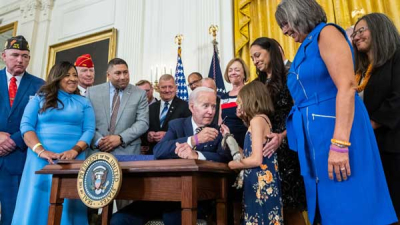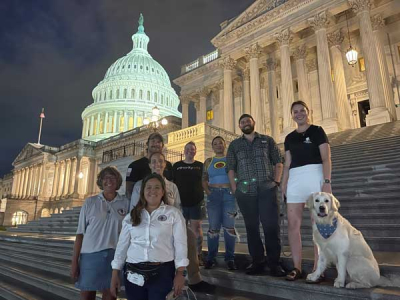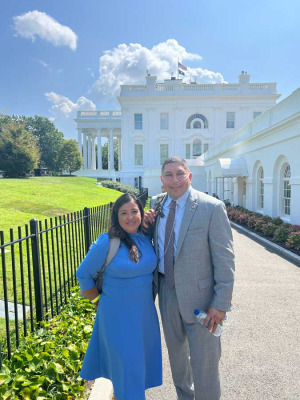‘Please Come and Apply’—The PACT Act Is the Largest Expansion of Veteran Benefits in Decades
On Aug. 2, after six days of sleeping on the steps of the Capitol Building in Washington, Rosie Lopez-Torres breathed a sigh of relief. The Senate, after considerable back and forth, finally passed the Sergeant First Class Heath Robinson Honoring our Promise to Address Comprehensive Toxics (PACT) Act.
The act ensures Veteran Affairs will approve certain disability claims for veterans exposed to toxins from burn pits, herbicides, and other sources during their service.

Senior Airman Frances Gavalis, 332nd Expeditionary Logistics Readiness Squadron equipment manager, tosses unserviceable uniform items into a burn pit at Balad Air Base in 2008. Photo by Senior Airman Julianne Showalter, courtesy of the Defense Department.
Lopez-Torres, the co-founder of the veterans’ advocacy group Burn Pits 360, camped out with other veterans and advocates to pressure senators to pass the act. Her husband, Le Roy Torres, also a co-founder, has complications relating to burn pit exposure in Iraq, and getting to this moment involved more than a decade of advocacy, rejections, and delays from VA.
A famous photo shows Lopez-Torres embracing comedian Jon Stewart after the law passed. But, she says, no one took a photo of her just before, as her knees buckled outside the Senate chamber and a veteran caught her.
“I felt like I was holding in 13 years of loss for my family,” Lopez-Torres says. “The loss of my husband’s job, the loss of his career, the compound loss, and all the veterans we lost along the way.”
On Aug. 10, President Joe Biden signed the PACT Act into law.

President Joe Biden hands a pen to Brielle Robinson after signing S. 3373, the “Sergeant First-Class Heath Robinson Honoring our Promises to Address Comprehensive Toxics (PACT) Act of 2022,” Aug. 10 at the White House. The bill is named for Brielle’s father, who passed away two years ago. Photo by Erin Scott, courtesy of the White House.
But, Lopez-Torres says, now comes the real work: making sure veterans can take advantage of changes in VA policy to get adequate care. Hidden in the 59 pages of legislative text and dense legalese, approaching deadlines and caveats could be worth thousands of dollars in benefits, vocational training, or home loan guarantees to veterans or surviving family members.
And, after an initial rush of publicity after Biden signed the law, only a fraction of veterans exposed to toxins have submitted new or supplemental PACT Act claims.
“We think that there are, roughly, a little over 6.2 million veterans who, we believe, qualify for the PACT Act,” VA Sec. Denis McDonough said at The War Horse Symposium in April. “Today, we’ve had about 450,000 veterans file a claim under the PACT Act. So you can see 450,000 and see a big number, or you can see a small number. I choose to see a small number—especially when we’re working with a denominator north of five million. Veterans in our care can get what’s called a ‘toxic exposure screening,’ which is, in effect, a conversation with your primary care provider about what you’ve experienced in terms of exposure. And we’ve now given about 2.3 million toxic exposure screenings. I actually legit see that as a big number.”
That number is now up to 3.3 million screenings, with 1.4 million veterans screening positive for at least one potential exposure, according to VA statistics from May 12.
Award-Winning Journalism in Your Inbox
The PACT Act brings the largest expansion of benefits to veterans and survivors in decades. It lists more than 20 illnesses veterans could have contracted following toxic exposure—such as brain cancer or lung disease, melanoma, or any reproductive cancer—and automatically presumes their service caused those illnesses. Clearing this hurdle—also known as a service-connected disability—makes it much more likely that VA will approve a claim.

Veterans Affairs Secretary Denis McDonough talks about the importance of signing up for toxic exposure benefits at The War Horse Symposium in Chicago in April. McDonough said the PACT Act became law faster than other benefits laws because President Joe Biden believes his son, Maj. Beau Biden, died from a brain tumor potentially caused by toxic exposure from the burn pits in Iraq. Photo by Babee Garcia/The War Horse.
Veterans can apply for benefits themselves with available VA forms, or use a VA-accredited service provider. (Veterans can check to see if an organization or person is accredited through VA’s website.) Veterans who file a claim may be eligible for immediate care. And advocates say veterans and survivors should apply as soon as possible to start the clock on a claim. This is especially true for surviving spouses, who can backdate claims to an original denial, whenever that occurred.
“The PACT Act is probably the most significant piece of veteran-friendly legislation in the last 50 years, if not of all time,” says Michael Figlioli, the national veterans services director for Veterans of Foreign Wars. “Now that the door is open, please come and apply.”
‘It Provides a Glide Path to Get Health Care’
If veterans can show they served in certain areas, such as on the ground or in the airspace above Afghanistan after 9/11, and have one of the service-connected ailments, they automatically qualify for benefits.
“It provides a glide path for those who have been exposed to get health care and claims done,” says Michael Stoddard, the Veterans Benefits Director at Wounded Warrior Project.
Because veterans couldn’t automatically prove service connection before the PACT Act, VA consistently denied toxic exposure claims. Before, veterans had to provide hard evidence to prove their illnesses came from toxic exposure, which could be an impossible task.

Burn pit activists camped overnight at the Capitol Building to protest after Republican senators blocked the PACT Act. They gave in after pressure from 9/11 activist John Feal and comedian Jon Stewart, as well as veterans service organizations. Photo courtesy of Rosie Lopez-Torres.
A veteran may have had constrictive bronchiolitis, and she may have served at Balad Air Base near a burn pit that spewed fumes from the 250 tons of trash a day it burned, but she couldn’t definitively prove the burn pit caused her constrictive bronchiolitis. As thousands of veterans began to experience similar symptoms, and as science pointed toward a connection, activists pushed to make getting benefits easier for people who served in places where they were likely exposed to environmental health hazards.
“It was difficult because, unless you had direct service connection and you had evidence that was empirical, you were more than likely gonna be denied benefits for any of those issues,” Figlioli says. “But now that they are presumptive issues presumed to have been caused by service, these are the easiest and quickest claims for VA to process.”
Three components must be met for a successful service-connected VA claim: an event, illness, or injury in service; a current diagnosis; and a medical opinion linking those two factors—or a “medical nexus.”
“There was nothing before the PACT Act that could draw in a service connection to some of those illnesses,” Stoddard says.
Starting more than a decade ago, VA refused to acknowledge that Le Roy Torres’s lung condition could have resulted from toxic exposure, Lopez-Torres says.

Rosie Lopez-Torres and Leroy Torrest stand in front of the White House after President Joe Biden signed the PACT Act. Photo courtesy of Rosie Lopez-Torres.
“At the time, the VA was grounded in their beliefs that there was no association between inhaling toxins and having any kind of lung issue,” Lopez-Torres says. “It was this issue of delay and denial, and they were not willing to go that extra step of diagnosing whatever the cause was.”
Kerry Baker, a senior appellate counsel at Hill and Ponton, helps veterans appeal claims VA has denied and has handled hundreds of toxic-exposure appeals. Activists hope the PACT Act will enable claims where veterans meet eligibility requirements to go forward smoothly, he says.
“Let’s say you’ve got a vet who served in Balad during the Iraq war, and that vet has lung cancer,” Baker says. “As long as the right application is filled out and sent to the right place, for all practical purposes, that claim should go through with no problem.”
According to the latest VA data, about 80% of 251,584 completed PACT Act claims have been approved as of May 12. Pact Act claims take an average of 156 days for VA to complete.

Smoke billows in from all sides at Balad Air Base, Iraq, in 2004 as Sgt. Richard Ganske, 84th Combat Engineer Battalion, pushes the bulldozer deep into the flames of the burn pit to keep burnable items constantly ablaze, disposing of them so they do not clutter up the post. Photo courtesy of the Defense Department.
Even veterans who haven’t filed claims or who are in the process can start getting care now because the PACT Act extends the time veterans have to enroll in VA health care to 10 years, rather than the five years veterans had before the act, after they get out of the military, McDonough says.
“You can start getting care—we have a window here early in the PACT Act that you can, so the initial five-year window for post-combat deployed veterans is now open,” McDonough says. “So if you come in, we can get you into care immediately.”
About 36,000 more people have enrolled in VA healthcare this year than at the same point last year, according to VA data.
In 2010, when Baker worked at the Veterans Benefits Administration, he spearheaded a burn pit policy to provide guidance and fact sheets to medical examiners who evaluated veterans dealing with toxic exposure.

Maj. Kate Little and Master Sgt. Robert Whitney from Team Soldier for Life attend the PACT Act Veteran and Benefits Fair at the Pentagon on March 22. Photo courtesy of the U.S. Army.
“It was basically everything we knew at the time about burn pits,” Baker says. “This was the first time that the VA had ever put out a policy like that with troops still on the ground.”
But, even with the policy in place, Kerry noticed that fact sheets weren’t being sent to examiners, and toxic exposure claims were still being consistently denied.
“A lot of people were going without the help they needed,” Baker says.
The PACT Act mandates toxic exposure screenings for veterans enrolled in VA health care. VA must also consider how toxic exposure affects the whole body, which opens the door for future presumptive illnesses.
“That’s really important,” Baker says. “That gives vets that may have a disability that’s not on this list a pretty good fighting chance to get an actual favorable opinion from the VA.”
‘It’s a Huge Lift off a Survivor’s Shoulders’
For survivors who have lost loved ones to toxic exposure, the PACT Act will retroactively consider claims VA denied before, potentially easing years of financial stress. Survivors can file for what’s known as dependency indemnity compensation claims, which provide monthly assistance if a veteran died of a now-presumptive illness. Under the PACT Act, VA will reassess previously denied dependency indemnity compensation claims back to the date of filing, which could be a decade or more for some survivors.
“It’s a huge lift off of a survivor’s shoulders,” Lopez-Torres says. “They might have exhausted all their life savings to get care for the death of their loved ones, to pay for hospice. Many of these women and men couldn’t go to work as they were watching their loved one die.”
So far, VA has completed about 5,600 survivor claims under the Pact Act.
The PACT Act expands VA health care for veterans with toxic exposure, furthers health care studies on veteran mortality, increases training on toxic exposures for VA staff, and provides funding for the construction of new VA facilities.
Section 804 of the act—also known as the Camp Lejeune Justice Act—streamlines the process for those exposed to contaminated water at the Marine base.
‘This Doesn’t Change the Process at All’
Filing a claim under the PACT Act is no different from filing any other VA claim, says Scott Hope, deputy national service director for training at the Disabled American Veterans.
“What everyone has to understand is, nothing changed as far as filing a claim,” Hope says. “This doesn’t change the process at all. It just opens the aperture more.”

Dan Clare speaks at The War Horse Symposium in Chicago in April. Clare worked as an Air Force public affairs officer at Balad Air Base in 2008 when he quietly leaked documents to reporter Kelly Kennedy showing the expected dangers of giant pits used to burn the military’s trash in Iraq and Afghanistan. Balad Air Base burned as much as 250 tons of trash a day in an open pit just a mile from where troops slept, exercised, and worked. Photo by Babee Garcia/The War Horse.
That’s not necessarily great news for anyone who has filed a VA claim before: Forms can be long and complicated, and filing the wrong form can trigger months of delays.
According to VA, there are several ways to file a PACT Act claim: online by yourself, by mail, in person at a VA regional office, or through an accredited representative.
The VFW, WWP, and DAV recommend using a VA-accredited organization like themselves to file claims, including by using their free online tools.
“The VA doesn’t even tell you what form you need,” Hope says. “So that’s why it’s very important to have somebody sit down with you. … You don’t know what you don’t know.”
Baker’s firm, Hill and Ponton, and Lopez-Torres’ organization, Burn Pits 360, also have free educational materials on their websites to help with claims.
A VA accreditation means service providers undergo an exam, as well as continual training, to help veterans file claims. Some providers can charge capped fees after VA has reached a determination in a claim. An accreditation is the difference between a veteran receiving free assistance from a trained professional or potentially shelling out thousands of dollars to a nonaccredited entity. (VA-accredited attorneys and agents can charge a reasonable fee, which cannot exceed one-third of any past-due benefit.)
“Avoid companies like Trajector or Veterans Guardian,” says Figlioli, who described those nonaccredited companies as “claim sharks” that charge exorbitantly for no additional benefit.

Comedian Jon Stewart interviews Deputy Secretary of Defense Kathleen Hicks at The War Horse Symposium in Chicago in April. Stewart helped Burnpits360 pressure Congress to pass the PACT Act, which ensures veterans have better access to benefits and care. Photo by Babee Garcia/The War Horse.
“Do not feed the shark,” he says. “They’re gonna take a huge percentage of your payment, and you could enter into an agreement that is going to cost you thousands and thousands of dollars when there is free help available.”
Trajector and Veterans Guardian did not reply to a request to comment on this claim.
If a veteran or survivor chooses to file a claim themselves, they must fill out several forms, depending on their circumstances. All new claims are filed on what’s called a 21-526EZ, Baker says. Veterans must also file a 526EZ when applying for a new disability rating on a previously approved claim that is more than a year old.
If VA has denied a claim a veteran filed before the PACT Act, the veteran must use a supplemental claim form, Baker says. A supplemental claim form can also be used to appeal a benefit determination at a local VA office.
If a veteran receives a request for application letter from VA, known as an RFA, then the veteran has filed the wrong form. An RFA includes only general language about a veteran’s application, but it’s essentially a rejection, Baker says.
“At the end of the day, that means that [VA] has canceled that claim,” Baker says. “You don’t get appellate rights to it, and they are not gonna revisit it or otherwise give you any further information, unless you give them the right form, which you may not understand from reading that letter.”
Even if a veteran has started a claim themselves, they can designate a power of attorney at any time to an accredited organization. A power of attorney will allow an accredited representative to look under the hood of an application and provide updates, Stoddard says.
‘You Never Know When an Old Claim Might Help You’
PACT Act claims can get tricky if a veteran has a pending claim for toxic exposure that they’ve been fighting with VA about for years, Baker says. If their claim under the PACT Act goes through, it will likely be effective only from August 2022, when the law was signed—and not when they first submitted a claim.
That gap, which could be years, will not be welcome news for veterans who’ve already waited years.
Baker, Lopez-Torres, and all of the veterans service organizations urge veterans to apply as soon as possible to get their claims into VA’s system, since the claims backlog is still high. About 210,000 claims seeking a disability rating have been pending for more than four months, according to VA claims data from May 13.
Importantly, if veterans file on or before Aug. 10, 2023, their claim will automatically backdate to Aug. 10, 2022, when the law was signed. Once a veteran begins an application online and fills in their personal information, they automatically have one year to complete the claim, which is called an “intent to file” in VA speak. The intent to file means the claim’s effective date will be the day the veteran started an application.

Deputy Secretary of Defense Kathleen Hicks, Veterans Affairs Deputy Secretary Donald Remy, and Under Secretary of Defense for Personnel and Readiness Gilbert R. Cisneros Jr. visit the PACT Act and Veteran Benefits Fair at the Pentagon in Washington, March 22. Photo by Tech. Sgt. Jack Sanders, courtesy of the Defense Department.
In addition to filing claims, the PACT Act opens VA health care eligibility to more veterans. VA defines veterans into three categories for the PACT Act, which correspond to whether veterans participated in a toxic exposure risk activity, served in certain locations, or participated in the post-9/11 operations in Iraq and Afghanistan. Desert Storm and Vietnam War veterans also have benefits available to them through the Pact Act.
Veterans who primarily served in combat zones after the Persian Gulf War and who were discharged or released between Sept. 11, 2001, and Oct. 1, 2013, have until Oct. 1, 2023, to enroll in VA health care, in a special open-enrollment period. If veterans miss this period of enrollment, eligibility becomes more difficult and is based on other factors, like VA pension status or financial need, according to the Veterans Benefits Administration, a branch of VA.
Our Journalism Depends on Your Support
Beginning Oct. 1, 2024, more categories of veterans will have open enrollment for VA health care on a rolling basis. VBA recommends veterans who are not enrolled in health care apply, even if they are unsure about their eligibility.
For veterans on the fence about filing a claim, Baker urges them to just apply, because laws might change later—to their benefit. The intense advocacy around the PACT Act is just one example.
“You never know when a claim that might be denied is going to benefit you down the road,” he said.
This War Horse feature was reported by Ishan Thakore, edited by Kelly Kennedy, fact-checked by Jasper Lo, and copy-edited by Mitchell Hansen-Dewar. Headlines are by Abbie Bennett.





Comments are closed.